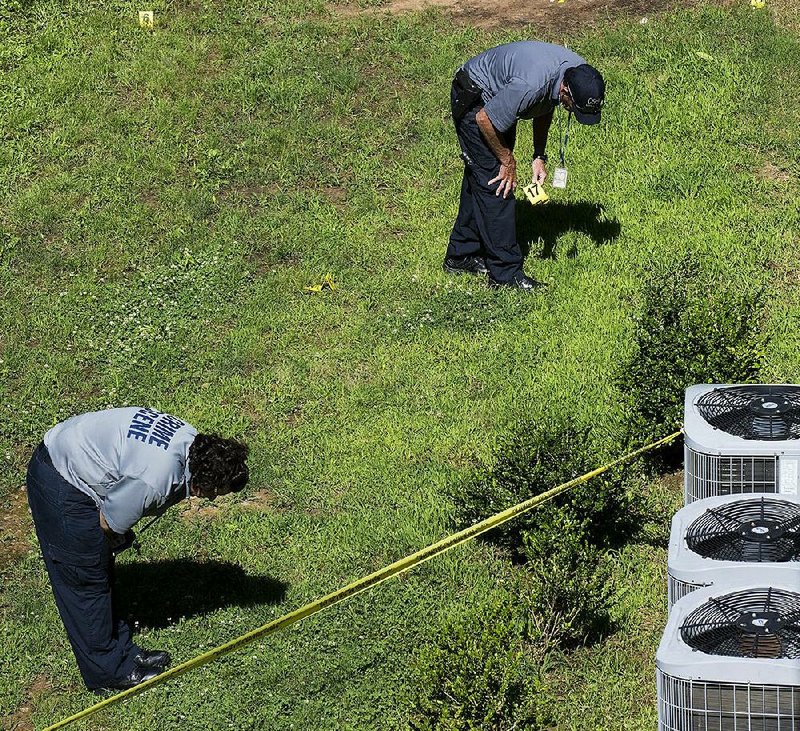Little Rock police are moving forward on plans to buy technology to pinpoint where gunfire occurs in the city with funding from a federal grant, instead of purchasing an in-house machine used to link shell casings found at different crime scenes.
Gunshot detection systems use sensors to specify the geographic location of gunfire. The technology, officials say, gives officers a better chance of locating shell casings, which can then be analyzed and used to provide links between incidents of gun violence.
"It puts a dot on the map," said Little Rock police Capt. Ty Tyrrell. "And the officer can see the dot on the map, and they'll go to that exact area and start looking for shell casings, as opposed to a three- or four-square-block area."
ShotSpotter, a gunshot detection system used in about 85 cities across the country, uses "strategically placed" sensors to detect and triangulate gunshots, according to the company's website. Once the incident has been confirmed as gunfire, a digital alert is sent to a 911 call center or to an officer's laptop or smartphone, the website said.
The company's website said ShotSpotter costs $65,000 to $90,000 annually per square mile of coverage, along with a one-time $10,000 service initiation fee per square mile.
Gunshot detection systems are used nationwide in large and small cities. New York, Washington, D.C., and San Francisco have all installed the systems, along with smaller municipalities such as San Pablo, Calif., according to ShotSpotter's website.
The $479,342 U.S. Department of Justice grant is also being used to help fund technology for a new Little Rock police unit aimed at targeting gun crimes by providing investigative leads to detectives in the department's Major Crimes division. Once fully operational, the new Little Rock unit will resemble a law enforcement model used nationwide in larger cities like Denver and Milwaukee.
Tyrrell, in an interview last month, said the department's Gun Crimes Intelligence Unit has been formed and is operating in a limited capacity. The unit includes three Little Rock detectives, and a fourth who is assigned to a federal task force and works part time with the gun crimes unit, he said.
The city is currently accepting bids for a gunshot detection system. The bid will close later this month.
The city's bid said the system should accurately locate gun shots and allow authorities to recover evidence in at least 70 percent of the incidents "in which multiple shots were fired in the defined area."
The system, according to the document, should also be able to identify the difference between a gunshot and other similar sounds, such as a car backfiring or fireworks.
Further, the bid said the system should be able to give a location of where shots occurred and a time stamp for when each shot was fired within a second, along with the audio recording and "acoustic signature" of a shot.
"We would use it to target those historical hot spots of crime," said Tyrrell, mentioning that the system would allow police to obtain information even in an incident without a witness.
Police departments in other cities have reported results from the technology. In Milwaukee, a gunshot detection system helped police in identify a house being used to sell firearms illegally, according to the a 2015 report from the Police Executive Research Forum. Customers, the document said, were stepping outside the house to test fire the weapons.
In the same report, a former Milwaukee police chief said that a gunshot system installed in a three-square-mile area found that 86 percent of gunfire incidents were not reported to authorities.
"Because gunfire was considered so common place, people didn't bother to call the police," the report said.
In Little Rock, department officials previously reported that the federal grant would allow Little Rock police to purchase their own National Integrated Ballistic Information Network machine, which can be used to determine whether shell casings found at different shooting scenes were fired from the same gun.
Having such a machine in-house would allow for a quicker turnaround on linking gun violence, Tyrrell said in December.
Right now, Little Rock police use a machine at the state Crime Laboratory. But officials have said they have limited access to the machine and the turnaround is too slow.
"You want to know about it right away, so the detectives can get something actionable quick," Tyrrell said last year, mentioning that an in-house machine could be available at all times.
The original grant was written up so Little Rock police would receive a gunshot detection system, he said in an interview last month. After getting the grant, the department then determined they would rather have a NIBINs machine more than a gunshot detection system, he said.
"So we thought maybe we could adjust the budget on the grant to drop gunshot detection and pick up NIBINs," he said. "We were not successful in that, so we're right back to getting our gunshot detection like originally planned."
Capt. Ken Temple, who oversees the division housing the new unit, said two of the unit's detectives will become certified as NIBINs examiners, something that is expected to cut down on the time it takes to link shell casings recovered from different crime scenes.
Temple said they hope to have the gun crimes unit running at full capacity as soon as possible, but did not specify a time.
A Section on 05/07/2018

